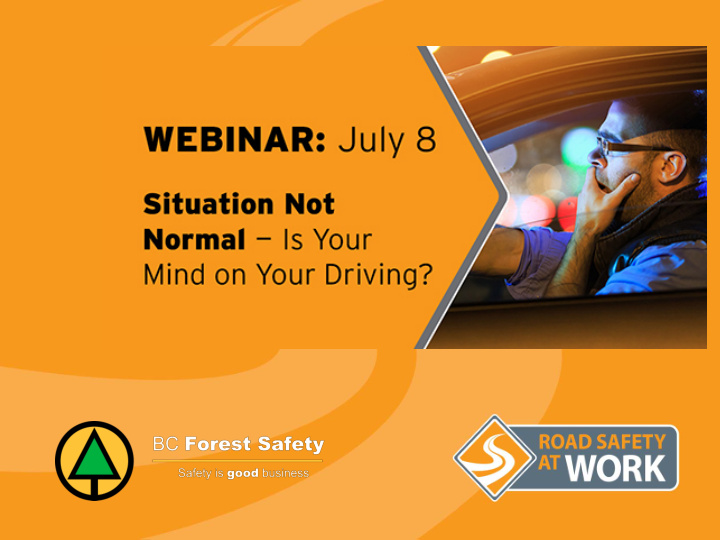



Audio instructions Select “Computer audio” to use your computer’s sound OR Select “Phone call” to dial in 2
Asking questions Click on “Questions” to expand the Questions pane Then Type your question to the moderator
Our webinar partner Dustin Meierhofer BC Forest Safety Director of Transportation Safety
About BC Forest Safety Created in September 2004; dedicated to the health and safety of BC forest workers. Services available to all forestry Road safety support services operations • Industry-led safety advisory groups • Safety program and COR audit • Resource road driver training assistance • Log truck driver training • Supervisor mentoring and skills development • Fatigue management • Serious incident investigation assistance • Injury prevention and claims management coaching
Introducing today’s presenters Angelina Robinson Road Safety At Work Client Relationship Manager Rick Walters Road Safety At Work Road Safety Manager 6
Overview • How and why not normal situations can affect your state of mind and contribute to crashes • Factors that contribute to risky driving behaviours • Explain how employers and employees can “ACE” risk reduction • Resources • Questions 7
Change is constant 8
Not normal = upset conditions • interruptions in regular work processes • disruptions in normal work activities • increased risk of incidents and injuries 9
Upset conditions use cognitive energy • Stress, unusual situations, life- changing events, and negative emotions incur high cognitive energy costs 10
….leading to risky driving behaviours • Irritability • Agitation • Frustration • Short temper • Aggressive driving 11
…. leading to risky driving behaviours 12
….and increasing your risks of being involved in a crash 13
Summary • “Not normal” situations such as disruptions or changes to normal processes = upset conditions • Upset conditions can negatively affect our emotions, reactions and ability to concentrate • Driving during upset conditions can increase the risk of a crash 14
Questions
Things employers can do 16
• Acknowledge that things are not normal • Identify what’s new or different about the workplace or work the driving employees do employee state of mind, fitness to drive 17
Click to go to the website 18
• Look for ways to reduce the driving employees do • No-travel options • No-driving options 19
• Free, mobile-friendly trip planning tool • 15 questions help prepare the driver and vehicle for the journey ahead • 2 trip plan forms • Print or email to share with supervisor and check-in contact Click to go to the website 20
What’s your training plan? • Does new normal include different driving assignments? • Do employees need to build additional skills? • What skills are required? • Training options available: behind-the-wheel, classroom, online, driving simulator, mentoring, etc. • Which methods work best? 21
• Build safety elements right into processes • Standard procedures include trip planning, vehicle inspections … and ACE • Monitor and be ready to make adjustments • Communicate 22
Things employees can do 23
Is this situation not normal? Is there anything unusual or different about: • my environment • my work assignment • me? 24
Cues to help you recognize not normal situations If you find yourself thinking: 25
Figure out what’s not normal. • What’s dangerous or different? • What’s worrying me? • What’s not normal? Get help from supervisor or co-worker. 26
Check in with yourself: • Am I fit to drive? • Am I mentally and physically ready to meet the demands of the driving tasks in front of me? • Self-check at the start of the day, during the day, and along the way. 27
Let assessment answers guide decisions and actions. Two components: • Determine the options • Choose the best one 28
Determine your options • Identify realistic possibilities. • Brain-storm, be creative to find better solutions. • Draw on knowledge and experience of others, especially supervisor. 29
Construct a plan Determine the best option • Choose the option that poses lowest risks • When there is no good solution because risks are too high…. • Get support and direction from supervisor 30
31
Learn, share and support • Work together to find solutions • Tell others about what you’ve found successful • Ask questions; find out what’s working for others • Support co-workers with your knowledge and experience 32
Summary • Upset conditions / not normal situations - big changes or smaller disruptions • Expose drivers to new hazards and different risks they aren’t prepared to deal with • Involve pressure, uncertainty and changes that cause feelings of frustration, inattentiveness, or worry • State of mind may tempt risky driving behaviours 33
Take-Aways 34
Questions
Contact us with your questions angelina.robinson@roadsafetyatwork.ca rick.walters@roadsafetyatwork.ca dmeierhofer@bcforestsafe.org
Visit our websites for more tools and resources https://roadsafetyatwork.ca bcforestsafe.org
Our Next Webinar At the Crossroads: How to Travel Through Intersections Safely September 23, 2020 In partnership with ICBC
Thank You! Follow Us On
Recommend
More recommend